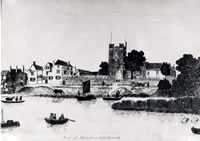Ferries & Ferrymen
... Rival ferries have been the subject of litigation more than once.


Rival ferries have been the subject of litigation more than once. In 1743 the Earl of Dysart started an action against a nearby ferry run by Margaret Langley and Samuel Keen. He won in 1746 but in 1915 Lord Dysart failed in his action against Walter Hammerton who had started a in 1908. Another ferry, the Buccleugh Ferry, shown crossing the river between Cambridge Park and Richmond on the 1894 Ordnance Survey, does not seem to have bothered Lord Dysart.
Charles Dickens wrote Little Dorrit in 1857 and in chapter XVII Arthur Clennam crossed to Ham and back on the Twickenham Ferry.
Twickenham Ferry is commemorated in a song written by Theo Marzials, first published in 1878.

Richmond Ferry existed before 1442 when, following Thomas Tyler, John Yong was granted the licence. Capable of taking carriages, it closed in 1777 when the bridge was opened. A ferry at Hampton Court superseded a ford some time before 1536 and was itself replaced by the first bridge in 1753. By 1519 Hampton village had its own ferry, which exists today. Teddington's ferry operated until about 1950, although business was lost when the suspension bridge was built in 1899.
As late as 1920 there were three other ferries between Kingston and Hampton Court: one crossing to Surbiton, one below the waterworks at Seething Wells and a third crossing to Thames Ditton.



